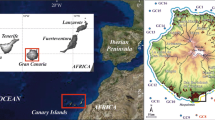Abstract
The 10-km long coastline of the Tabarka–Berkoukech on the northwestern Mediterranean coast of Tunisian is characterized by marked morphological features, including embayments, long extensions, headlands, pocket beaches, sand dunes and sea-cliffs. The undulated nature of this coastline has permit sand, originated from three rivers, to confine between headlands, embayments, pocket beaches and the downdrift leeside of Tabarka Harbor breakwaters. Wave-related coastal processes simulated by STWAVE model together with the analysis of aerial photographs are jointly combined to evaluate degree of stability of this coastline. Analysis of aerial photographs dated 1963 and 2001 (38 years) using the Digital Shoreline Analysis System document significant beach changes in the sandy beaches. Maximum accretion occurs downdrift of Tabarak Port (3.8 meter/year), followed eastward by a minor erosion of −1.5 meter/year at El Morjene beach. The morphological characteristics of this coastline exhibit a wide range of beach dynamics resulted from interactions of waves, shoreline orientation and sediment supply. Pattern of longshore sediment transport direction has been deduced from the interplay between incident waves versus average shoreline orientation (angle of incidence). Results indicate that the W and NW waves are responsible for the generation of the sediment transport to the east throughout the year. This transport process is also accompanied with a net westerly reversals induced from the N and NE waves. Such wave reversibility, in general, generates a long-term equilibrium between the opposing east and westward sand movement within the coastline, yielding to an effective zero net littoral drift with a minimum sand loss resulting in stable beaches. Collectively, results obtained are jointly discussed in the context of sustainable management of this coastline.

Similar content being viewed by others
References
Paskoff R.: Eroding Tunisian beaches: causes and mitigation. Bollettino di Oceanologia teorica ed applicata 10, 85–91 (1992)
Oueslati, A.: Les côtes de la Tunisie, recherches sur leur évolution au Quaternaire. Doctorat Es-Sciences, F.L.S.H.T. (1994)
Halouani N., Sabatier F., Gueddari M., Fleury J.: Evolution du trait de côte de Tabarka-Bouterfess, Nord-Ouest de la Tunisie. Méditerranée N° 108, 131–137 (2007)
Oueslati, A.: Coastal morphology and sea level rise consequences in Tunisia. In: Changing Climate and Coast, vol. 2, pp. 211–223, p. 518. Western Africa, The Americans, the Mediterranean Basin, and the Rest of Europe, United Nations Environment Programme (1990)
Oueslati, A.: Littoral et aménagement en Tunisie : des enseignements de l’expérience du vingtième siècle et de l’approche géoarchéologique à l’enquête prospective, Orbis. Tunis, p. 534 (2004)
Paskoff, R.; Sanlaville, P.: Les côtes de la Tunisie, variations du niveau de la mer depuis le Tyrrhénien. Maison Orient Méditerranéen, sér. Geogr., vol. 14, p. 192 (1983)
Boukaaba, M.: Étude de la stabilité du littoral de Tabaarka-Zouaraa, mémoire DEA, Fac. Sc. Tunis, p. 115 (1997)
Halouani, N.; Fathallah, S.; Gueddari, M.: Beach and nearshore morphodynamic changes of the Tabarka coast, northwest of Tunisia. Environ. Earth Sci. J. (2011, in press)
Saadaoui, M.: Erosion et transport solide en Tunisie, mesure et prévision du transport solide dans les basins versants et de l’envasement dans les retenues de barrages. Ministère de l’Agriculture, Direction des Ressources en Eau, Rapport Int., p. 30 (1995)
Smith, J.M.; Militello, A.; Smith, S.J.: Modeling waves at Ponce de Leon Inlet, Florida. In: Proceedings of 5th International Workshop on Wave Hindcasting and Forecasting, pp. 201–214. Environment Canada, Downsview, Ontario (1998)
Smith, J.M.; Resio, D.T.; Zundel, A.K.: STWAVE: steady-state spectral wave model. Instruction Report CHL-99-March 1999, U.S. Army Engineer Waterways Experiment Station, Vicksburg, MS.10. (1999)
Smith, J.M.; Sherlock, A.R.; Resio, D.T.: STWAVE: steady-state Spectral Wave Model, user’s manual for STWAVE, Version 3.0. USACE, Engineer Research and Development Center, Technical Report ERDC/CHL SR-01-1, Vicksburg, MS 80 (2001)
Resio D.T.: Shallow-water waves. I: Theory. J. Waterway Port Coastal Ocean Eng. 113(3), 264–281 (1987)
Resio D.T.: Shallow-water waves. II: Data comparisons. J. Waterway Port Coastal Ocean Eng. 114(1), 50–65 (1988a)
Resio, D.T.: A steady-state wave model for coastal applications. In: Proceeding of the 21st International conference in Coastal Engineering. ASCE, pp. 929–940 (1988b)
Battjes, J.A; Janssen, J.P.: Energy loss and set-up due to breaking of randomwaves. Proceedings of 23rd International Conference Coastal Engineering, ASCE, pp. 569–587 (1978)
Thieler, E.R.; Himmelstoss, E.A.; Zichichi, J.L.; Miller, T.L.: Digital Shoreline Analysis System (DSAS) version 3.0; an Arc GIS extension for calculating shoreline change. U.S. Geological Survey Open-File Report 2005-1304 (2005)
Hidrothecnica Portugesa, H.P.: Etude générale pour la protection du littoral tunisien.Rapport I–II–III–IV et V, Ministère de l’Equipement Tunisien, p. 300 (1995)
BCEOM; STUDI: Étude de l’extension des ports de pêche de Tabarka et Kelibia, problèmes de transit littoral et de sédimentation (1981)
Mangor, K.: Shoreline management guidelines, p. 232 (2001). Handbook, Delft Hydraulics, Water & Environment, Denmark
CERC (Shore Protection Manual): U.S. Army Corps of Engineering Research Center, p. 214. Government Printing Office, Washington D.C (1984)
Jlassi, F.: Risques naturels et problèmes d’environnement à Tabarka et ses environs. Mémoire C.A.R. Fac. Sc. Hum. Tunis, p. 170 (1993)
Inman, D.L.: Littoral cells. In: Schwartz, M. (ed.) Encyclopedia of Coastal Sciences, pp. 594–599. Springer, Dordrecht (2005)
Frihy O.E.: Morphodynamic implications for shoreline management of the western Mediterranean sector of Egypt. Environ. Geol. 58, 1177–1189 (2009)
Frihy, O.E.; Hassan, A.N.; El Sayed, W.R.; Iskander, M.M.; Sherif, Y.: Best practice for environmentally friendly-designed sea shore recreational facilities: case studies from the Red Sea, Egypt. Ecol. Eng. 24, 1–12 (2006)
Author information
Authors and Affiliations
Corresponding author
Rights and permissions
About this article
Cite this article
Halouani, N., Gueddari, M. & Frihy, O. The Northwestern Mediterranean Coast of Tunisia: Wave Processes, Shoreline Stability and Management Implications. Arab J Sci Eng 38, 1851–1860 (2013). https://doi.org/10.1007/s13369-012-0401-4
Received:
Accepted:
Published:
Issue Date:
DOI: https://doi.org/10.1007/s13369-012-0401-4




